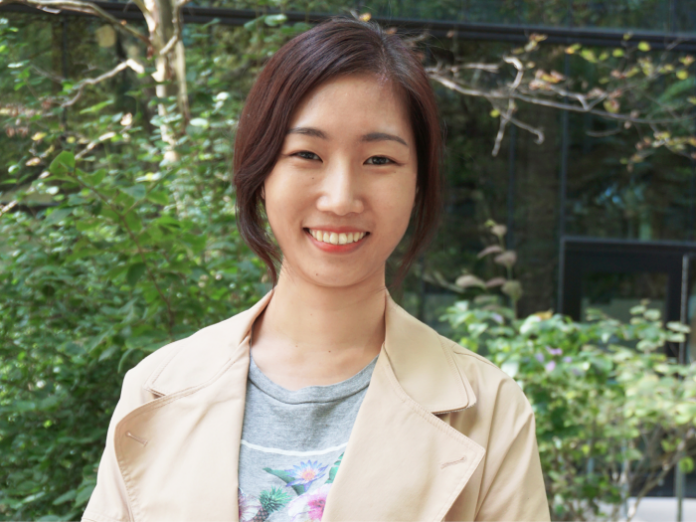by Liam Smith, 2019
Transcript:
L:
I just had some questions and it’s just an informal conversation. So is there anything from your research that, specifically relating to your piece about taking detours, was there anything that kind of surprised you or was counterintuitive to what you may have thought would have been?
Y:
So, first of all, the bike infrastructure, as you may know, there’s different types of bike infrastructure. For example, there’s a bicycle trail which is a dedicated route for a bicyclist and there’s also bike lanes, which is dedicated but it’s right next to the roadway and also there’s a bike sharrow. A bike sharrow is just a shared roadway that is shared by drivers and also by cyclists. There’s a sign in the road that you need to share with this bicyclist, so I was wondering what [effects] these different types of infrastructure had on bicyclist route preferences and choices.
When bicyclists choose their routes, to which routes they [actually] took. So first of all, there’s a different effect for example bike trails and bike sharrows. So if bicycles are willing to go take a larger detour, they tend to strongly prefer these bike trails because bike trails are, especially geographically, very sparse. It exists only in special, particular places like next to Olentangy River. So if they are willing to take a wrong route, they strongly prefer these bike trails but on the other hand, the bike sharrows, if people think that “I don’t want to go you know further away from the shortest routes,” they tend to prefer the bike sharrows. If there are roads that are close by, they tend to prefer roads with bike sharrows rather than just a normal road. But, if people want to choose these bike trails, they never use these bike sharrows. So bike sharrows are for those who want to take a shorter routes and bike trails are people who want to combine these recreational rides and also these commuting or other utilitarian-purpose rides. So these have different effects then. That was what actually surprised me in terms of the poly investment. So both of these infrastructure have different uses, and different kinds of utilities for different types of bicyclists so we need to care about these different types of infrastructure. That was one of the main findings in my study.
L:
That’s really interesting. I found something similar in my own [research], because I’ve been doing a survey too and talking to cyclists and stuff like that. What kinds of opportunities do you think you may have identified for improvement for the future? Besides expanding infrastructure and obviously having more trails, do you think there’s something missing right now?
Y:
Personally, my research interest includes active mobility, including bicycling and also walkability. And also I’m interested in this green-space planning in urban area because it gives people shade and cleaner air quality. Bicyclists and pedestrians are more likely to be exposed to this external environment in terms of air and this hot temperature. I wanted to focus on this green-space planning and want to see this green-space planning combined with active-mobility planning. If we are able to invest more public money on infrastructure, maybe this infrastructure can be combined and can be considered in conjunction with tree-planting programs. If we are able to plant trees alongside these roads it can give shade and cyclists may find it more pleasant to ride under the shade. They may prefer this semi-natural environment if they are riding outside so maybe tree-planting, and landscaping may be relevant to promote more bicycling.
L:
Yeah because I think you said they prefer more exposures to green-spaces when on their routes.
Y:
Yeah, right. So they are exposed to more green space. There’s a lot of individual differences in these preferences actually. I think more hardcore cyclists, they may not care about these green spaces but, for example for females, and also the elderly, or maybe children, they are more vulnerable to this hot temperature, sun light, and air quality. We may want to have them placed along more naturally favorable environments. One of these opportunities may include tree-planting and also lawn-planting alongside this roads.
L:
How big of a factor do you think safety is in terms of these detours? You said something about people being more inclined to take the trail if they’re gonna go farther away.
Y:
Safety is a super important factor actually. So in terms of safety, people really care about speed limits. Many people found that traffic congestion is an important factor that made people take a detour, take a longer than necessary route and I found that the speed limit itself is also a risk factor. Even though there’s less cars on the road, people still feel threatened if cars pass by really fast. Then, if there’s an encounter, like accidents between bicyclists and car, if it’s happened with a really high-speed car, the severity of this accident will be really chronic and serious. People feel more threatened when they ride on the road with very high speed limit like main street. We have sections that have a speed limit greater than 45 miles per hour and I found that people usually prefer roads that have a speed limit less than at least 30 miles per hour or maybe 25. But 45, over 45, is really an inhibiting factor that made people take a longer route.
L:
Yeah, I think I found something similar too. I was interviewing people about what they felt was the scariest part about interacting with cars and distracted driving and speed differential were the biggest factors.
Y:
Yes and also there’s another factor, that people want to avoid as many left turns as possible.
L:
Yeah I remember.
Y:
Right, so if they had to make a left turn, the driver’s left turns are like a crossroad. Then you may not be able to see those people crossing the road and also the same for bicyclists, they try to avoid this left turn in terms of safety. Their safety and also the safety of others. They care about this, safety of others. I have also interviewed some people who are really avid bicyclists and also people for non bicyclists. Their opinions also matter I guess, because they have this willingness to ride a bike to come to campus for the environment and also for their health. But they are hesitant because they have seen their close ones and their friends or family members, they have seen some people that they know are involved in a crash, like a car and bicyclist crash. They’re like feeling it’s not safe. It’s unconditionally not safe to ride a bike to campus, so in terms of this safety there is not only this physical environment, but also this peer effects is very important to address the safety concern..
L:
Yeah I’ve read some other articles that have the driver’s perspective and then pedestrians and cyclists and it’s really interesting to see the differences.
Y:
Yeah, yeah, some pedestrian hate cyclists. They think right of way belongs to pedestrians. If somebody could ride a bike in a Park area, this is not encouraged actually by the City of Columbus or city council. They discourage bicyclists from riding a bike within the park because many pedestrians and exercising people are there so these people, they hate bicyclists to ride a bike so their opinion really matters.
L:
So what is your view on having a bike lane that’s separated like on Summit? Have you ever seen that one? Where the parking is in the middle versus having the bike lane directly part of the road?
Y:
Yeah it may be called bike boulevard I think. A bike lane is a little bit lower quality than that and it’s actually a bike boulevard. This Mid-Ohio Planning Council Commission, they are planning these bike boulevards where they see higher demand for bike infrastructure and I think these bike boulevards are really great infrastructure and in addition to this quality infrastructure, what is really important is the connectivity of these bike routes. If there’s really good bike infrastructure but these bike routes are not connected, or don’t have smooth connectivity to other infrastructure, and it’s like it’s only for these routes. People are less likely to use that because if you’re a bicyclist, they hate to stop at traffic light even. They want a smooth and continuous ride so a bike boulevard is really perfect and if we are able to improve this infrastructure to another level, to a higher level, then the connectivity is also the most important factor.
L:
Definitely, I think I was reading about that in terms of the infrastructure in New York City. The city is doing lots to add more stuff but it’s not really connected so it’s not necessarily improving the safety.
Y:
Yeah, but actually boulevards are really great because bike trails you need to go there right? you need to go down there and you have to go up, so it takes a lot of transition between no more road and bike trail. I think bike boulevards are more exciting personally and it’s actually on the road and you could see more commercial stores and houses. It might be more pleasant for people so I think it’s a good infrastructure. And since I know you are in industrial design, so you’re more interested in this design aspect of infrastructure I think.
L:
Mmm-hmm, I haven’t focused yet but yeah that’s definitely a factor.
Y:
Yeah, I think that’s pretty good stuff. Actually this small street, I guess, street furniture these are really important. I mean these beginners, people who are willing to ride a bike, but they’re hesitating, those people have a high potential that we could really engage in and encourage bicycling so in terms of their perspective, the small street furniture definitely matter to make them feel it might be safe for them.
L:
Yeah so do you know of any kind of important factors that go into deciding where bike trails or bike boulevards and lanes get put in or is it just focused mostly on demand and real estate and stuff like that?
Y:
That’s really a great question. So these days, as you may know, there’s a lot of voluntary geostatistical data, so people are voluntarily uploading their bike trajectory using their phone GPS. So there’s a whole lot of different types of geospatial data that planners can use to plan and make a decision on where to put those bike infrastructure. But one of the biases that these kinds of data has is that only bicyclists upload the data. So people who don’t bike, since they don’t have this trajectory, they don’t upload their data online so we are kind of subconsciously ignoring their opinion. Since if there is a bike trail here, maybe people living close to this bike infrastructure are more likely to ride a bike. We are unconsciously putting more weight on these people’s opinions and at the same time you’re ignoring people maybe on the outside of the neighborhood so that’s a really important question and I’m not saying I have a clear answer to that. It’s really important but it’s really curious, I mean, it’s a really critical, crucial question.
I have another study on bike choice, actually, bike choice so people choose to ride to campus area. So I found that people who [are] living in high-density, more mixed land-use neighborhood, for example in downtown, or near the area along campus, they are more willing to take a bike since the environment is favorable to them, because there’s a lot of pedestrians and many traffic, but I don’t know. Maybe there are more hipsters than people living in a suburban area. They are more willing to take a bike; so if we are going to place our public money to get maximum effect, I think people living in this higher density area, more high-rise buildings, maybe we could place bike sharing infrastructure or bike racks or bike routes like summit road. These are the more-than-moderate density neighborhood in our urban planning perspective so I prefer this area rather than these conventional, traditional neighborhood types where people are more reliant on driving.
L:
So one more question and this goes back to what we talked about before, but would you say in terms of going forward, the main focus should be on connecting existing bike trails or just having more bike infrastructure or a mix?
Y:
Yeah I mean this is a very, super important question. This is a really hot topic right now in academia. I think you really get to the point. So where to place those infrastructure is also important and also how we could better utilize the existing infrastructure and how we could get a maximum benefit out of this existing facilities. I think, so you’re talking about the priority right?
L:
Yeah because I know there is quite a bit of existing infrastructure but it’s not super connected so it’s a bit inconvenient to make the most of it.
Y:
I would say I know this is my personal opinion and I haven’t done any research about that aspect and it’s really important. Maybe you could pursue it in the future. I think in terms of the accessibility of this bike infrastructure, I would think that maybe it’ll be better for more people to have access to bike infrastructure. So if we could create an environment that more people, without any demographic, or you know socioeconomic status, they had the right to see these infrastructure near their neighborhood. I would say connectivity also matters but if we need to invest money, I would say in terms of this accessibility,I would like to install more infrastructure under those, you know, infrastructure-desert neighborhoods.
L:
Yeah, alright, well thank you!
Y:
Great, thank you!




